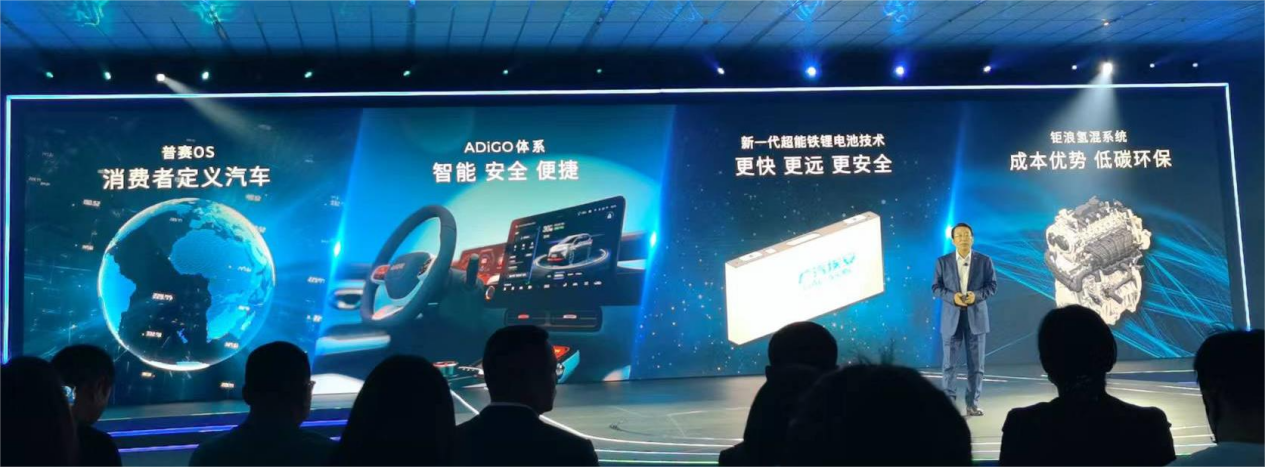Traditional automakers shift focus to underlying technologies in tech companies
The traditional focus of bottom-up technical innovations for automakers has shifted from the fuel power system and industrial design in manufacturing enterprises to the direction of technology companies, such as operating systems, artificial intelligence, and material innovation. Tesla and XPeng Motors are leading this charge.
On June 28th, GAC Group Technology Day showcased a series of core underlying technologies in the electric intelligent field:
In the intelligent Internet of Vehicles field, it unveiled the Pusai OS under the Xingling architecture and the evolved ADiGO intelligent driving interconnection ecosystem;
In the field of electrification, it launched the microcrystal technology’s super-powered lithium iron battery, the giant wave hybrid modular architecture, and hydrogen engine, and released a hydrogen energy concept car―Green Space.
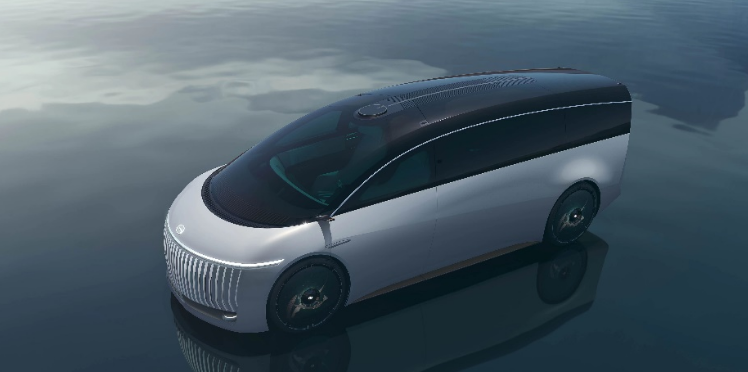
As Aiways gradually enters the leading camp of the new energy vehicle market and verifies its technical capabilities in electrification, GAC has further exerted efforts in smart and cutting-edge technology fields.
The underlying operating system Pusai OS and ADiGO PILOT, divided into high/mid computing power platform, provide a foundation for GAC to catch up with Tesla and XPeng in the field of intelligence. The microcrystal technology’s super-powered lithium iron battery and giant wave hybrid architecture further expanded the core and perimeter of GAC’s electrification.
At the press conference, Wu Jian, director of GAC Research Institute, and others introduced the above-mentioned content.
Launching Pusai OS
If the composition of smart cars is compared to that of computers, GAC’s focus on intelligence this time is mainly on upgrading the operating system and software.
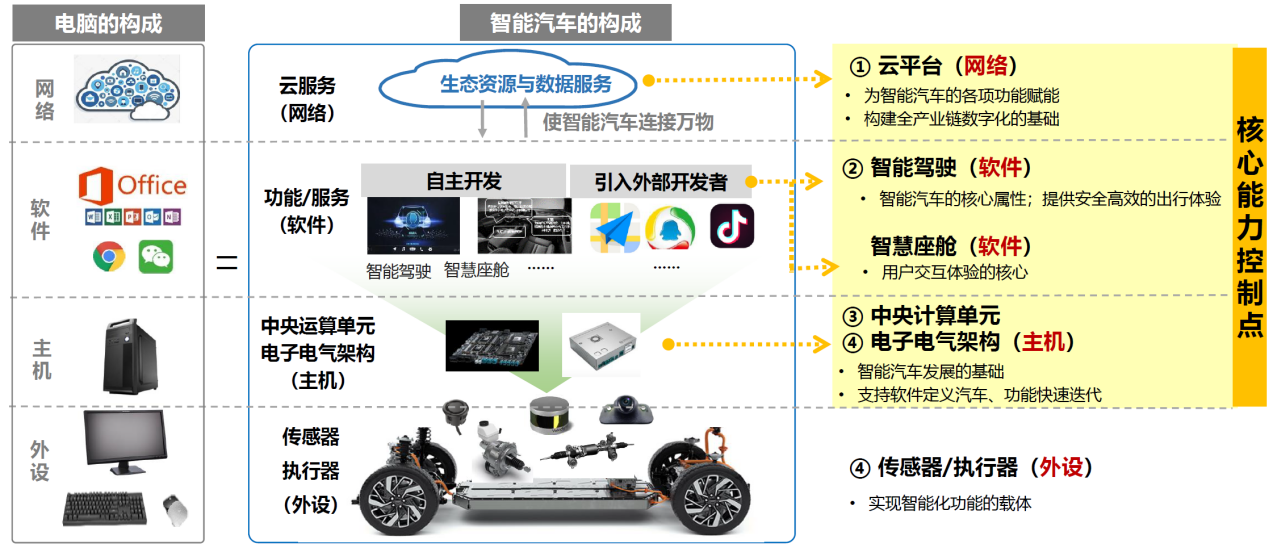
If GAC’s Xingling electronic electrical architecture is understood as a computer host, then Pusai OS can be understood as the operating system of a computer.
In terms of operating system, GAC hopes to connect standards and modes of smart driving, information entertainment, and intelligent vehicle control in various fields. Pusai OS is a standardized operating system that spans the entire vehicle.
Pusai OS includes the SOA cross-domain service engine, high-performance middleware engine, vehicle cloud image engine, and heterogeneous execution scheduling engine.
The feature of Pusai OS is that it creates a unified interface definition and core component, which integrates the central computer, intelligent driving computer, and information entertainment computer at the software level, making the operation of the electronic and electrical architecture more efficient. At the same time, it also lays the foundation for GAC to achieve bi-domain or even tri-domain fusion in the next step.In the view of GAC, Psa OS is the core of GAC Starlink architecture “aiming towards the future”. It has the characteristics of efficient collaboration, minimal reuse, and unified vehicle cloud, which effectively improves the compatibility and reuse of software, greatly enhances the efficiency of software development and iteration speed, and transforms software iteration from monthly to minute units, which can significantly improve the consumer experience.
Upgrade of ADiGO Ecosystem
ADiGO is the iterative upgrade of software, which can be compared to OFFICE software in terms of hierarchy.
In the automotive field, GAC ADiGO is the ecosystem of smart driving, and it has been continuously upgraded since its launch. This time, the ADiGO ecosystem has been upgraded again, divided into two systems: ADiGO SPACE and ADiGO PILOT, focusing on the core user experience of smart cockpit and intelligent driving.
ADiGO SPACE Smart Cockpit
ADiGO SPACE Smart Cockpit system is driven by specific application scenarios, trying to build a “smart cockpit that understands users better.” Therefore, ADiGO SPACE is upgraded from four aspects: voice capability, sound experience, ecological content, and scene solution.

For example, the coverage rate of the wake-up function reaches 95%, and the wake-up time is less than 0.6 seconds. It introduces in-car vinyl music. In terms of entertainment functions, it introduces head ecological content, and cooperates with brands such as Tencent, Himalaya, and BiliBili. In terms of smart scene solution, it covers travel scenes and supports user customization.
ADiGO PILOT Intelligent Driving
Intelligent driving is much more complex than smart cockpit.
At the afternoon salon, Xu Wei, the head of the intelligent driving technology department of GAC Research Institute, detailed the idea of GAC’s smart driving.
Xu Wei explained that based on the trend of technology development and the market positioning of GAC products, they divided intelligent driving into three tracks: driving assistance, advanced intelligent driving, and unmanned driving. Among them, the advanced intelligent driving track will become the main competition field in the future, which is the key to the bend overtaking of the car companies and technological transformation, as well as the pillar of future survival.

ADiGO PILOT intelligent driving system is equipped with 39 high-performance sensors, including 3 intelligent variable focal length solid-state lidars, 6 8 million pixel high-definition cameras, the first in the industry to equip infrared cameras, and 8 major redundant systems. It is equipped with a high-performance computing platform and is aimed at advanced auxiliary driving, super parking, and unmanned driving.Guangzhou Automobile Group has divided ADiGO PILOT into two major platforms: a high computing power platform and a medium computing power platform.
According to Xu Wei, there are many Guangzhou Automobile Group products, and it is difficult to adapt them to different price points with one system. Therefore, ADiGO PILOT has been divided into two major platforms based on different needs.
Under the high computing power platform, Guangzhou Automobile Group’s NDA (Navigated Driving of ADiGO PILOT) can achieve functions such as automatic on/off ramps, lane changing, overtaking, and obstacle avoidance according to the navigation path. It has currently covered all highways in China as well as the fast roads and main roads of core cities.

Of course, Guangzhou Automobile Group has also provided some comparison data. In terms of high-speed scenarios and urban traffic lights, among other aspects, they have performed well compared to other competitors.
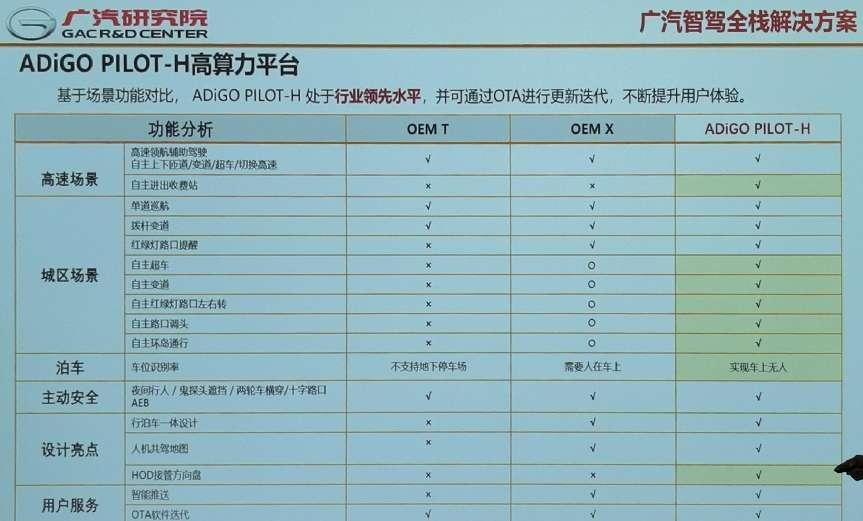
The medium computing power platform corresponds to ADiGO PILOT’s Super Parking function, which focuses on implementing “last mile” smart driving by solving parking pain points.
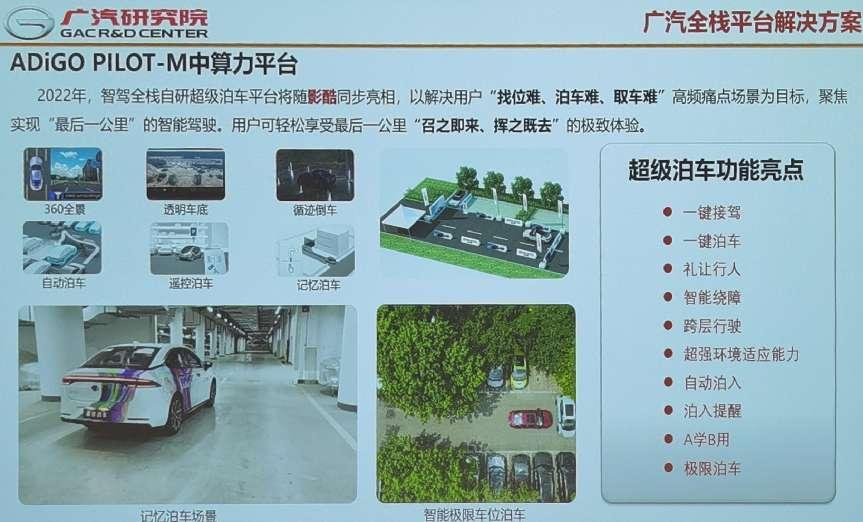
Xu Wei mentioned that their design philosophy for parking is to make Guangzhou Automobile Group able to park in spots that no one else wants to park in. “Our engineers came up with many names—’corner parking spots’, ‘VVIP exclusive parking spots’, because no one else can park in them.”
According to Guangzhou Automotive Group, they support more than 50 complex parking scenarios, not only supporting ultra-small parking spaces with a 15cm distance but also fully automated parking in corner spots.
In the field of autonomous driving, Guangzhou Automotive Group insists on advanced technology implementation and actively promotes commercial implementation. ADiGO PILOT autonomous driving is a solution for the Robotaxi scenario.
The idea at Guangzhou Automotive Group is to expand the L2++ high computing power platform into an L4-level Robotaxi platform.
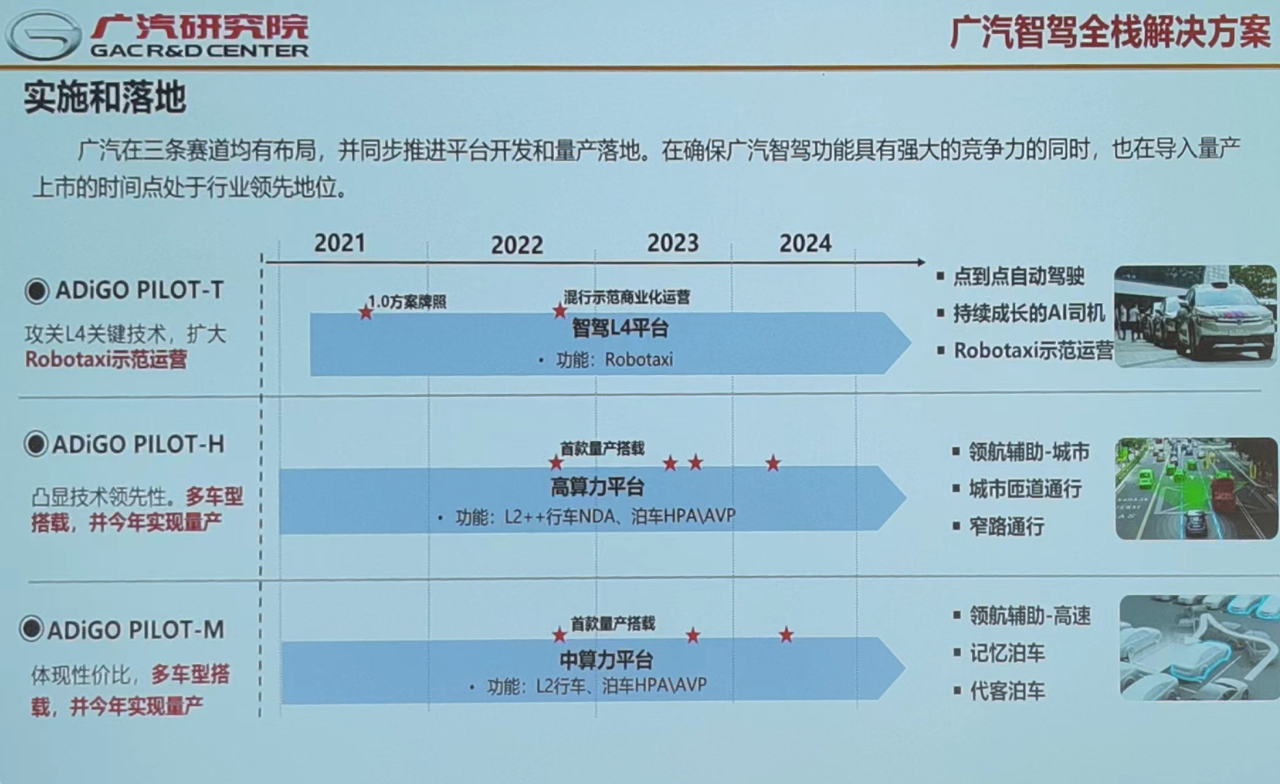 # Guangzhou Automobile Group’s Robotaxi Operation Technology Platform
# Guangzhou Automobile Group’s Robotaxi Operation Technology Platform
Guangzhou Automobile Group’s subsidiary, Ruiqi Chuxing, also exhibited the Ruiqi Robotaxi operation technology platform for the first time at the Technology Day. Ruiqi Chuxing will open it to all automatic driving technology companies that meet the standards, and co-promote Robotaxi demonstration operations. It is expected that a fleet of more than 200 Robotaxi vehicles will be formed for mixed demonstration operations in Guangzhou by 2022, opening a new stage of commercial unmanned driving.

Xu Wei also stated that Level 2 driving assistance is a relatively mature technology and Guangzhou Auto will not invest in it. Instead, we will cooperate with existing suppliers to promote mass production and cultivate users’ usage habits. With regard to level 4 autonomous driving, we will adopt a full-stack self-research mode.
Microcrystal Technology Super Energy Lithium Iron Battery
At Technology Day, Guangzhou Automobile also released a new battery cell, the Microcrystal Technology Super Energy Lithium Iron Battery.
According to the data provided by Guangzhou Auto, this super energy lithium iron battery has an energy density that is 13.5% higher than that of the current mass-produced lithium iron phosphate battery cell on the market, and a volume energy density that is 20% higher. The low-temperature capacity can be increased by about 10% at -20°C, and fast charging can reach over 2C. The power battery life can reach more than 1.5 million kilometers (>4000 weeks @80%).
This battery cell improves on the basis of lithium iron phosphate by introducing a higher-capacity second-phase positive electrode microcrystal and optimizing fast charging, low-temperature, and durability issues through ion multi-channel shunting technology, cathode potential energy buffer technology, and OCV three-dimensional space response surface reconstruction technology.
As it involves commercial secrets, Guangzhou Auto did not give more explanation on the second-phase positive electrode microcrystal. Li Jin, the head of the battery research and development department of Guangzhou Aiai Research and Development Center, simply stated that it is a material for which Guangzhou Auto has conducted independent research and development.
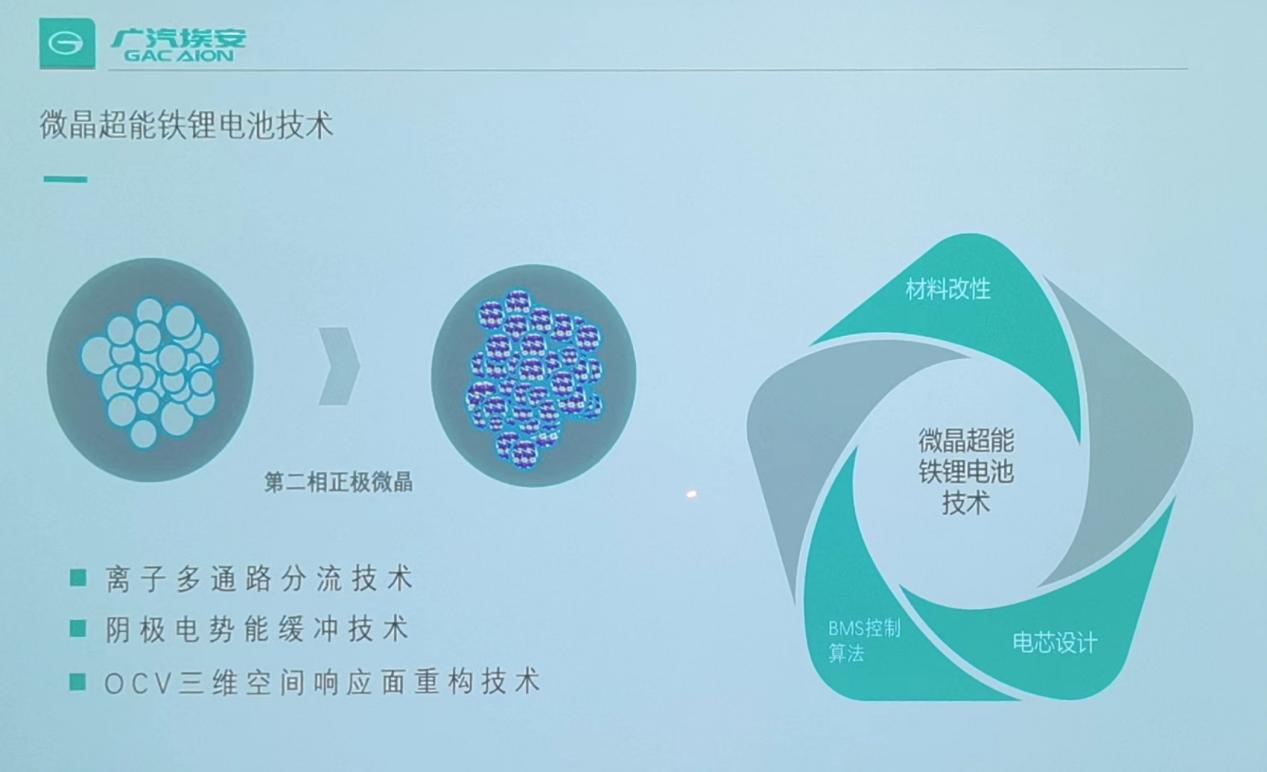
Regarding the multi-channel shunting technology, Li Jin explained that after the microcrystals are introduced, the internal gaps of the electrodes are distributed more evenly, which is conducive to the infiltration of the electrolyte and beneficial for the ion migration during the charging and discharging process. Overall, its effect is to reduce the polarization of the battery and make the current density distribution more uniform.
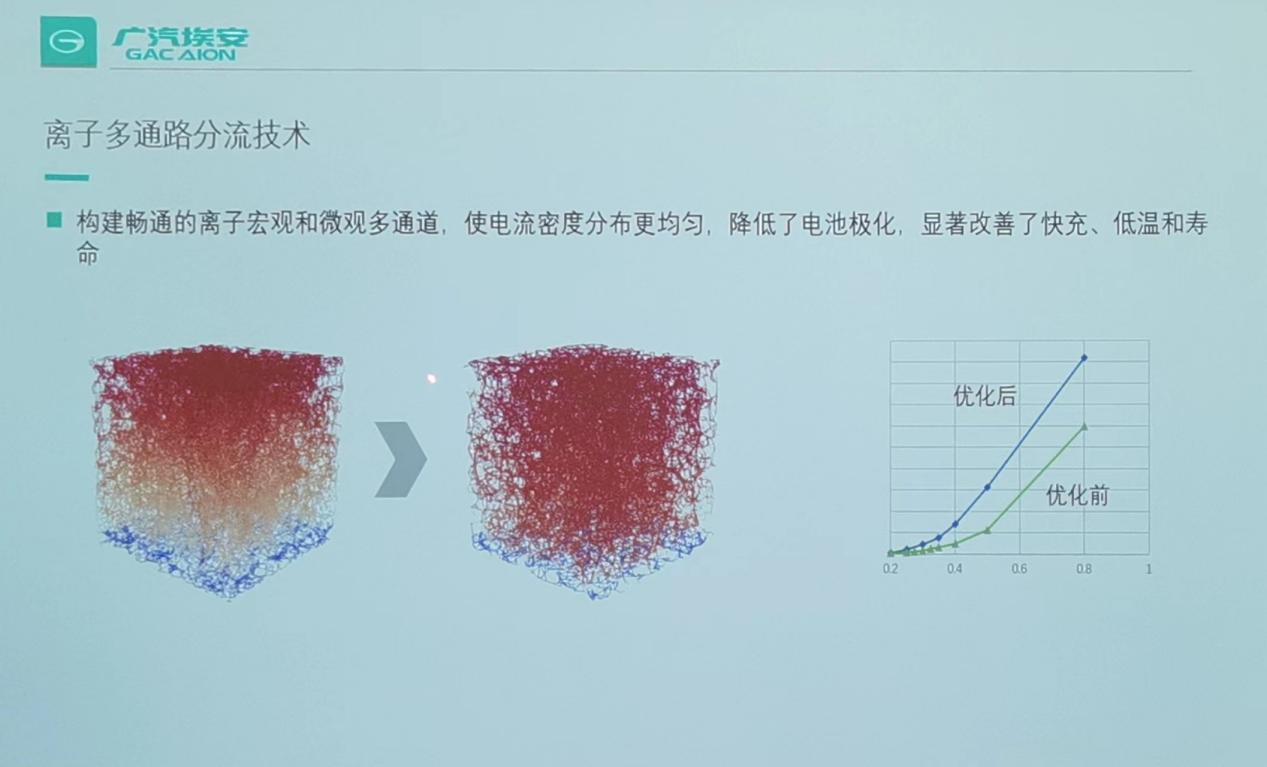
The so-called cathode potential energy buffer technology establishes interface modification at the material surface. During the discharge process, electrons spontaneously flow to the positive electrode, that is, from the high potential to low potential, changing from the original “one-stage waterfall” structure to a “two-stage waterfall” structure, which improves the stability of the positive electrode interface and structure.
There is another important technology called OCV three-dimensional response surface reconstruction technology. Li Jin introduced that they used actual vehicle data collection, by collecting the actual SOC data of a small interval and fitting it with historical storage data, the SOC curve can be reversed and the overall BMS estimation accuracy can be greatly improved.
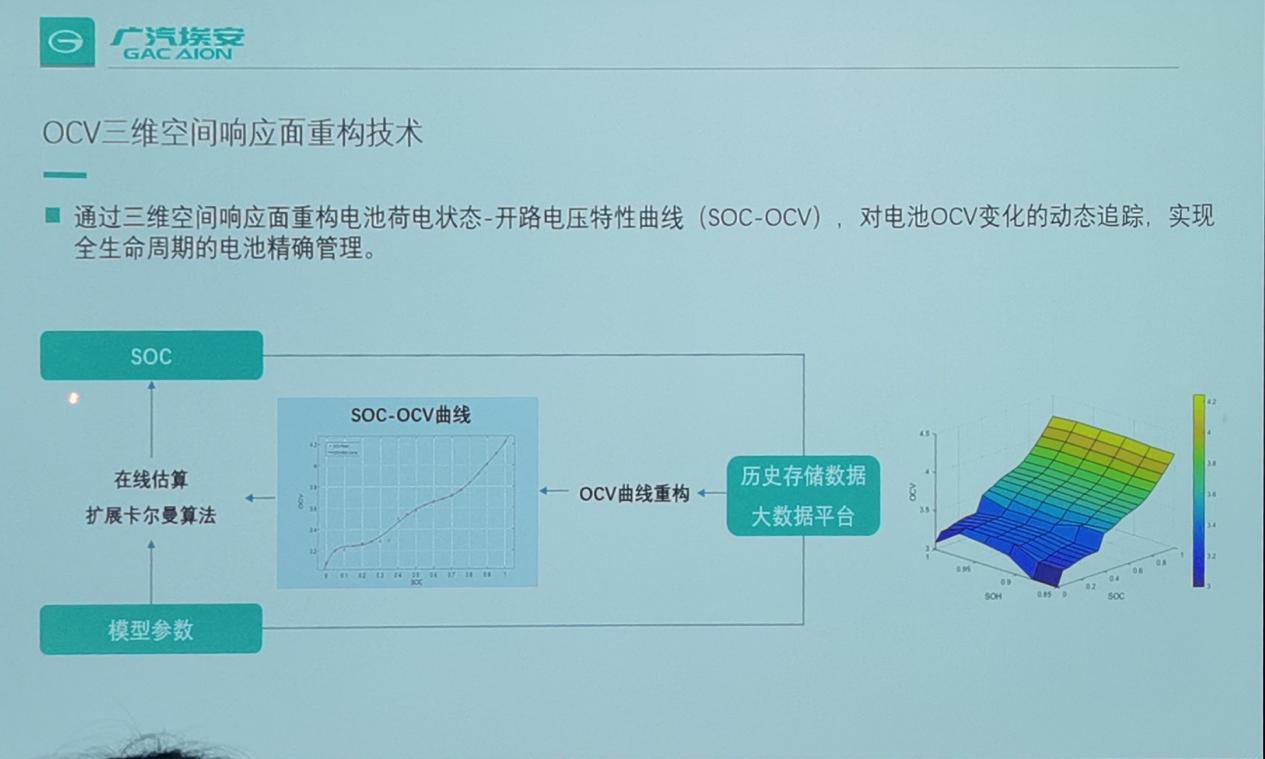
In Li Jin’s opinion, the energy density and life of lithium iron phosphate batteries cannot be achieved at the same time. Most of them have a energy density of 180-190Wh/kg, and the cycle life is about 2500-3000 weeks. Guangqi’s microcrystalline technology, SupEnergy lithium iron phosphate battery, increase the cycle life to 4000 weeks, and at the same time, the low temperature capacity and fast charging are significantly improved.
Li Jin gave an example. Generally, it takes 34 minutes to charge a lithium iron phosphate battery to 80%, while they can reduce it to 26 minutes or even less.
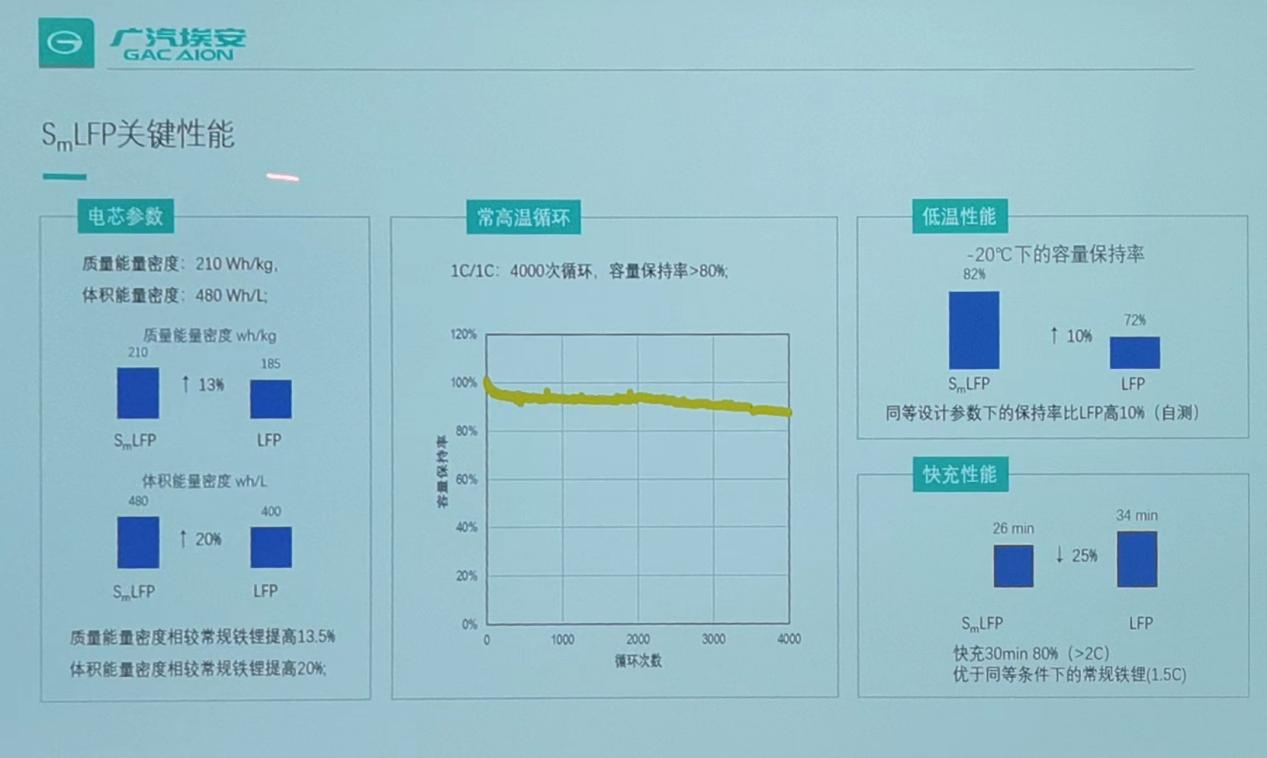
In terms of safety, the technology has a slight decrease compared to lithium iron phosphate, but it can still pass the squeeze test, puncture test, and battery pack thermal runaway test.
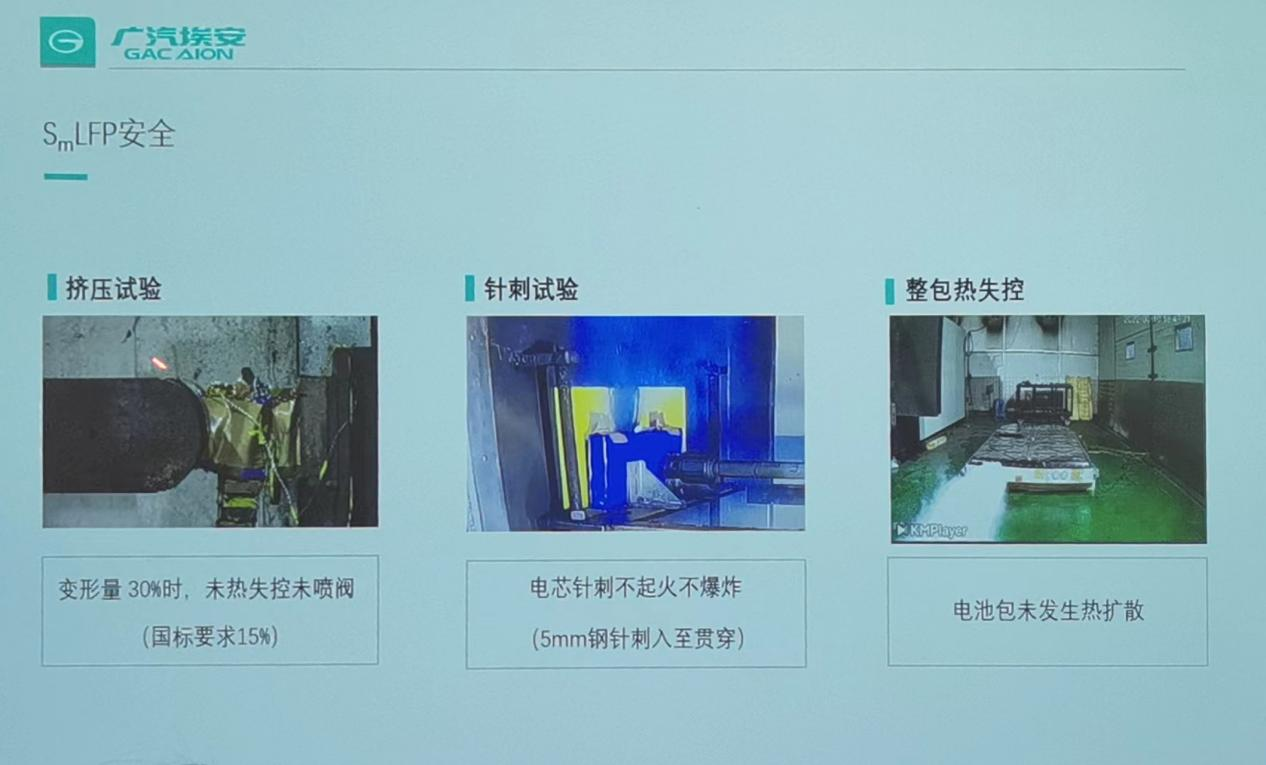
JULE Hybrid Modular Architecture
As a company that started with fuel vehicles, hybrid technology is also an important part of Guangqi’s low-carbon development.
In April of this year, a brand new hybrid technology brand, JULE Hybrid, was released. At the Guangqi Tech Day, the JULE Hybrid modular architecture, which supports the JULE Hybrid technology, was officially released.
The architecture consists of three major parts: hybrid engine (E), electromechanical coupling system (M), and power battery (B). Adopting a platform-based and modular design, the architecture has strong compatibility and universality, and can derive four major categories and N total combinations, adapting to all XEV models such as HEV, PHEV, and REEV.
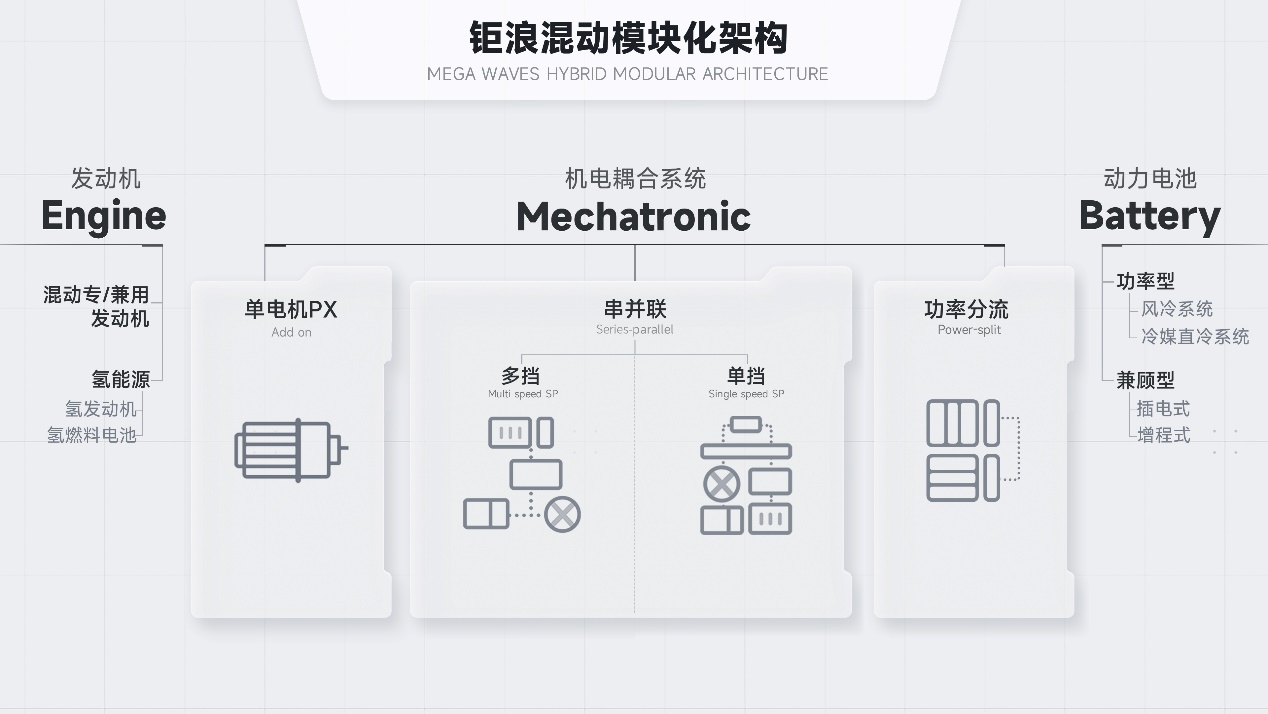
The four major categories under the JULE Hybrid modular architecture include the cost-effective single-speed system, the power-type power-split system, the power-saving multi-speed system, and the efficient zero-carbon hydrogen-hybrid system. Among them, the representative of the efficient zero-carbon hydrogen-hybrid system is the JULE hydrogen-hybrid system that makes its debut this time.The system consists of a hydrogen internal combustion engine and the Guangqi Mechatronics Coupling system (GMC), with hydrogen consumption less than 0.84kg per 100 kilometers, achieving true carbon neutrality while ensuring power through hybrid technology.
The first hydrogen engine from GAC, featuring hydrogen direct-injection technology, successfully ignited in September 2021, with a verified operational duration of over 12,000 hours and a potential thermal efficiency of 44%, truly achieving “zero carbon emissions”.
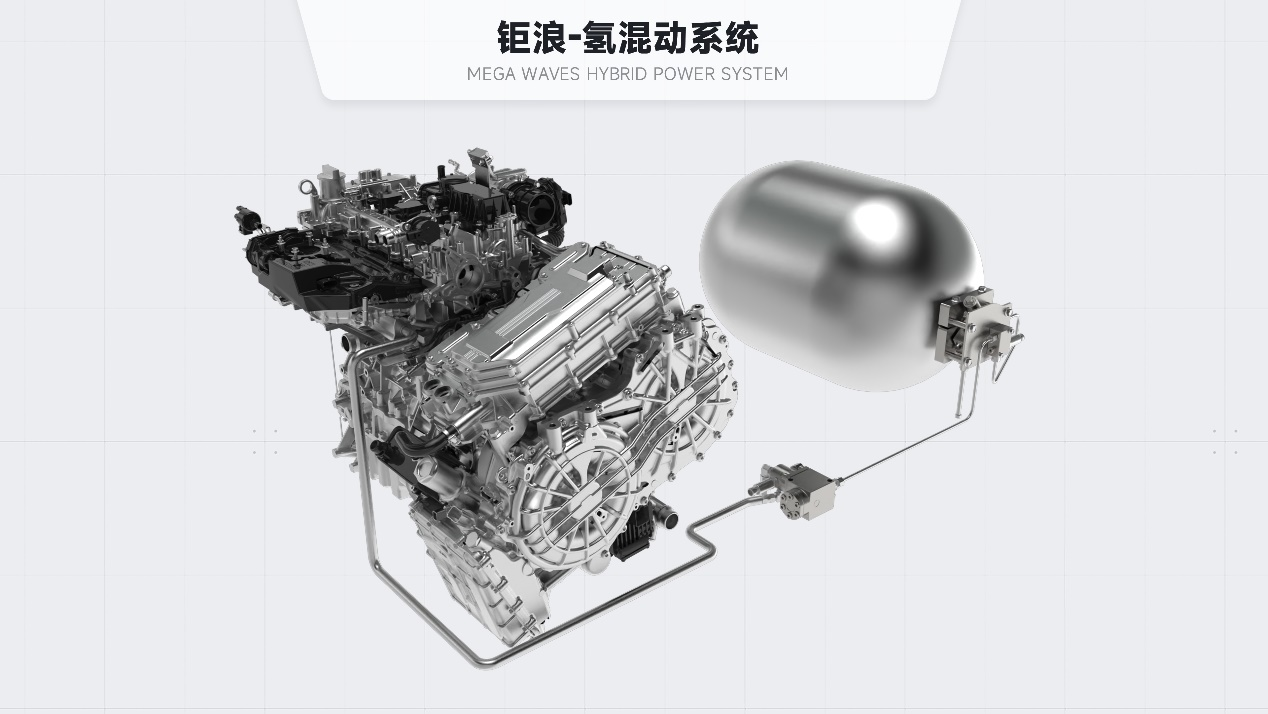
The GMC system of Guangqi Mechatronics Coupling features high efficiency, high performance, high integration, and is compatible with all XEV models. This year, GAC Trumpchi will launch its flagship MPV model, equipped with high-torque GMC, with a pure electric range exceeding 100km and a system comprehensive power of 270kW.
Unlike pure electric vehicle companies that only focus on intelligent and pure electric drivetrain systems, GAC Group, as a company with a variety of powertrain products, needs to consider more diverse and complex products.
As technology advances, “reusability” is one of GAC’s most mentioned words, and it is also at the core of the overall design philosophy, which undoubtedly brings more challenges to product architecture design but is also key to reducing costs and increasing efficiency. Let us wait and see the actual effect of these modular and reusable technologies.
This article is a translation by ChatGPT of a Chinese report from 42HOW. If you have any questions about it, please email bd@42how.com.
